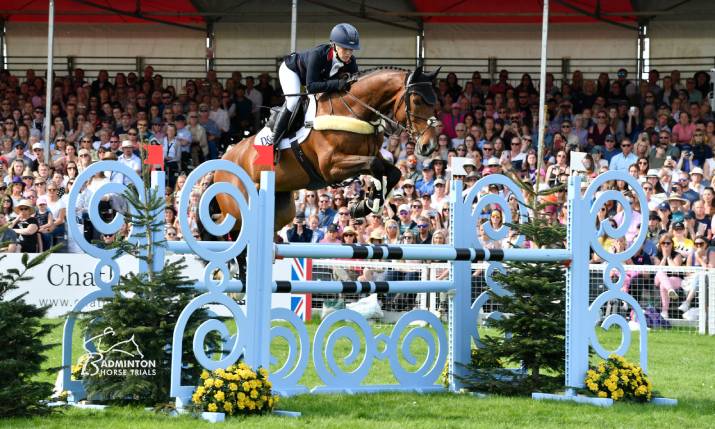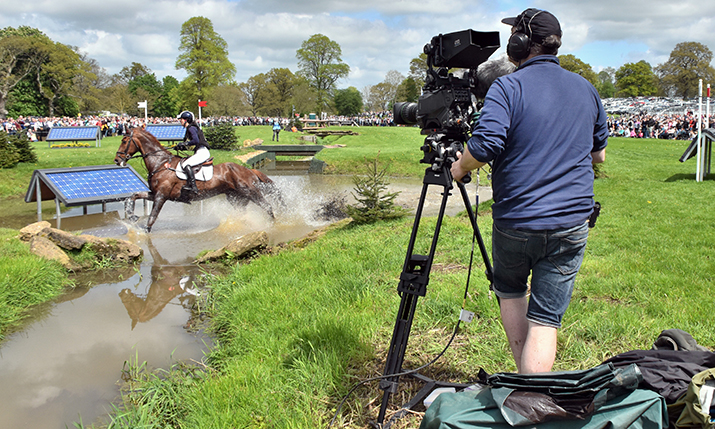Jumping obstacles: EMG deploys expansive operation for Badminton Horse Trials

Up and over at the Badminton Horse Trials
The Badminton Horse Trials is one of the world’s toughest equestrian events, seen as the pinnacle of the horse trials calendar. Set across the expansive grounds of Badminton House in Gloucestershire, the event has been running since 1949 and was first televised in 1956. Things have changed a little on the broadcast front since then.
This year (4-8 May 2023), EMG deployed a large OB operation comprising around 40 staff, two OB trucks, 20 cameras and a drone on site over the four days. EMG works with Badminton TV to stream the event live, with a highlights show on BBC on Monday 8 May.
“We start on Thursday by getting everything rigged for the dressage, and we cover that on the Friday and Saturday from 10 o’clock in the morning until about 4pm. Then on Saturday, it’s a quick turnaround to get everything out into the cross country. We don’t really finish rigging until Saturday night to be ready because it’s so vast”
It’s the 14th time EMG has covered the event, with unit and technical manager Joe Flower comparing it in a geographical scale to a high-level golf tournament.
“It’s quite a large operation in terms of terms of personnel,” says Flower. “We have over 50 staff in total, comprising, engineers, graphics, a ten-strong edit team, as well as 20 camera operators plus jib assistants.”
The course is different every year, so a month before the event Flower goes around the course with the course planners, accompanied by Chris Lewis Media (EMG’s client for the coverage) and the BBC.
“The infrastructure is the biggest problem on the job,” says Flower. “Sometimes the course runs where a cable would have been last year, so it’s just tying it all together.”

For the Badminton Horse Trials 2023, EMG deployed a large OB operation comprising around 40 staff, two OB trucks, 20 cameras and a drone on site over the four days
Ground control
The trials kick off with two days of dressage in an arena, but the cross-country event on Day 3 (Sunday) poses the biggest challenge, both for the competitors and the broadcast crew. The course of four miles sees the horses jumping a series of man-made and natural obstacles within a set time. Then on Day 4, it’s back to the arena for a course of show jumping.
EMG’s triple-expanding truck Nova 134 is the heart of the on-site production, supplying subscription-based internet TV channel Badminton TV, which streams live and catch-up footage via the Brightcove platform.
“We have a VT truck, which does all the edit and the VT side of things, we have a tender support vehicle from which we run the Badminton TV commentary, and we also have a cabin to do the voiceover dub for the cross country,” explains Flower.
EMG does a submix for the cross-country coverage. “Our 20 cross-country cameras are split across two directors, in order to control it a bit more,” Flower explains. “Predominantly what they look for is being able to see the jump, but once they’ve done the jump, we want to be able to swing the camera shot so that it passes on to the next jump for continuity. So every camera needs to be positioned to be able to see the approach, the jump, and the away.”
“After the cross country everything shrinks down into a six camera OB for the show jumping,” he adds.
In terms of camera comms everything goes through the CCU. “There are headsets and radio kit for all of the crew, the audio crew, vision crew and riggers, everyone else is on a handheld radio,” says Flower. “We have comms to the Badminton show itself; it’s so vast and everyone’s on an-event wide channel, including electricians and the PA system. So, if anyone needs something or if cables are going the wrong way or whatever, everyone can be in touch with each other.”
Live presentations take place at the end of the cross country and during the show jumping. “We do the presentation from the arena,” says Flower. “It’s a standard presentation. Just one single handheld RF camera that comes in and rigs on Saturday, ready for the Sunday, with main RF mics and a backup system. The mics go out on the Tannoy so we give feeds to people doing the PA system.”

The trials kick off with two days of dressage in an arena, but the cross-country event on Day 3 (Sunday) poses the biggest challenge, both for the competitors and the broadcast crew. A muddy OB compound after the weekend rain
Big rig
According to Flower, the event demands a, “three day constant rig”, even while individual events are taking place. “We start on Thursday by getting everything rigged for the dressage, and we cover that on the Friday and Saturday from 10 o’clock in the morning until about 4pm,” Flower explains. “Then on Saturday, it’s a quick turnaround to get everything out into the cross country. We don’t really finish rigging until Saturday night to be ready because it’s so vast.
“There are fourteen extra cameras that need to go out [on the cross-country course],” he continues. “We can’t put out any camera heads on Thursday or Friday, as we can’t leave them out, for security reasons. So we have to check all those cameras before they get rigged.”
And there are a lot of cameras and lenses to check: “We run twenty Sony HDC-3500 and HDC-4300 heads. Because of the distances involved, we use longer lenses, such as the Canon Digisuper 86. On the jibs, we use Canon HJ11 lenses to get nice wide shots, and we have some HJ14 lenses sprinkled around.
“Every camera is manned bar one on the show jumping, which we have on lock off,” adds Flower. “There’s also drone coverage round the lake, and then for four to five jumps across a long stretch. It looks great.”
The drone is supplied by Steve Peters Drones, piloted from an area on the course by Badminton Lake. “Essentially when they get to a certain point in the course, there’s such a break that to cover it and to cable would be too costly,” explains Flower. “And it’s much nicer to have on the drone.”

Over the solar panel fences at the halfway point of the 4.2 mile (6,700m) course. “The public is in on Thursday for what they call the ‘trot up’ where they come and have a look at all the horses that are going to be competing,” says EMG unit and technical manager, Joe Flower. “So you have to get through the crowd with the vehicles and all the camera kit… going all around it just takes forever”
Clip clop
Sound is provided by on-camera audio. “It’s a stereo show. On every camera we put out we have a Sennheiser 416 or 816 Rifle Microphone, depending on how far away they are from the course,” says Flower. “That all gets brought back through camera channels.”
The camera positions are spread out across the whole estate, connected by a fibre infrastructure pre-installed by a third party. It remains on site throughout the year.
“After a year of it being underground, the challenge is in digging it out, getting all the dirt and water out, and making sure everything works. You never quite know what you’re going to get.
“We’ve set out hubs that run all the cable to and from the trucks; we run fibres to our hubs, and then bring the cameras back to them. Some of the distances are 1,200 metres per camera from each hub. So geographically and logistically, it’s quite a tough challenge.”
This is hampered by the fact that from the Thursday ticket holders are allowed into the grounds.
“The public is in on Thursday for what they call the ‘trot up’ where they come and have a look at all the horses that are going to be competing,” says Flower. “So you have to get through the crowd with the vehicles and all the camera kit… going all around it just takes forever. It’s such a challenging operation in terms of getting everything ready because you move everywhere at a snail’s pace.
“[On Saturday] we test it all, drone included, and get ready for Sunday when we cover around ten hours’ worth of cross-country,” continues Flower. “We then spin round all the footage into an edit which gets dubbed on Monday ready for the TX by the BBC. While that’s going on, we cover the show jumping, which runs a solid eight hours.
“The show is quite complex in that sense because even when we’re broadcasting the show jumping, there are people in the background, rigging cameras, doing all the stuff that goes on behind the scenes still needs to be done.”
Flower feels the spectacle on the Sunday makes up for all the effort of the previous three days. “I’m not really a horse person, but the cross country is great,” he says. “It’s a lush place to be, so all the different camera shots look really cool. It certainly keeps you entertained.”
More Badminton Horse Trials: Picture gallery

